INXA AI Agents
INXA AI Agents
INXA AI Agents are intelligent virtual assistants integrated into the Nexth Experiential Phygital All-in-One XClub platform.
These Ai Agents Text-to-Business are designed to enhance user interactions by providing complex actions real-time support, phygital API Interactions, personalized interactive recommendations and insights, making the platform more intuitive and user-friendly.
Overview
INXA AI Agents leverage advanced artificial intelligence technologies to understand and respond to user needs effectively. They play a crucial role in the Nexth.one ecosystem by facilitating seamless interactions between users and the platform's various features.
From Fragmentation to Semplification
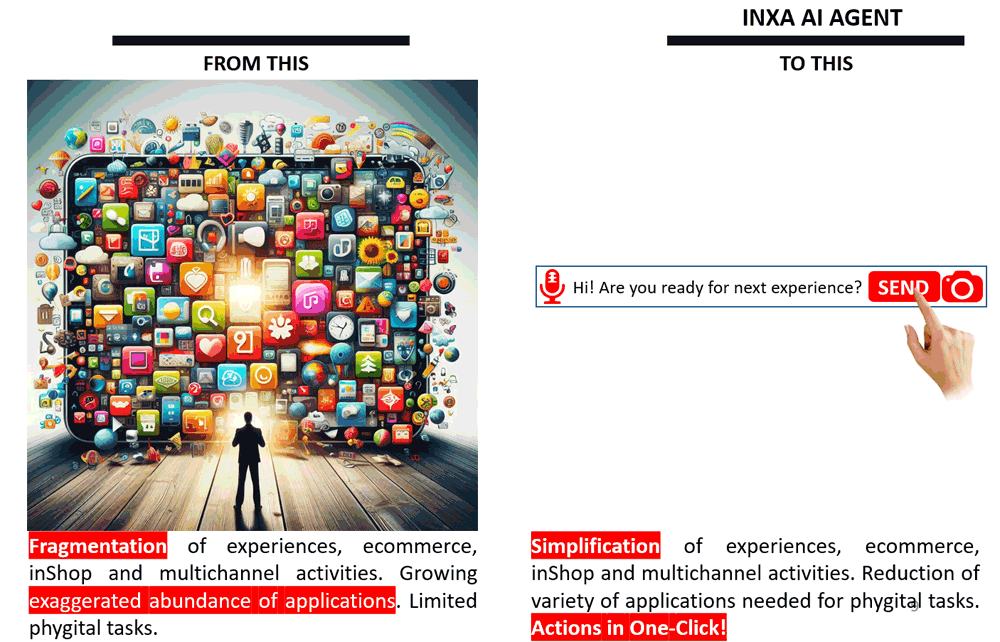
Fragmentation of Experiences in E-commerce and Multichannel Activities
The Challenge of Fragmentation
In today's digital age, consumers are inundated with a vast array of e-commerce platforms, applications, and shopping experiences. This phenomenon, known as the fragmentation of experiences, poses significant challenges for both businesses and consumers. The proliferation of countless apps and channels has led to an exaggerated abundance of options, often overwhelming users and diluting brand engagement.
E-commerce and InShop Integration
As e-commerce continues to grow, the integration of online and in-store (InShop) experiences becomes crucial. However, the seamless blending of these channels is often hampered by the sheer number of applications and platforms. Consumers expect a unified experience, whether they are shopping online or in-store, but the reality is often a fragmented journey. This disjointed approach can lead to confusion, reduced customer satisfaction, and ultimately, lower sales.
Multichannel Activities
Businesses today are leveraging multiple channels to reach their customers, including websites, mobile apps, social media, and physical stores. While multichannel strategies aim to enhance customer engagement and convenience, the excessive abundance of platforms can create inconsistencies in the user experience. Customers might encounter different pricing, availability, and promotions across channels, leading to frustration and mistrust.
The Problem with Exaggerated Abundance
The proliferation of e-commerce applications and platforms has led to an exaggerated abundance that overwhelms consumers. With so many options, users struggle to find and stick with the platforms that best meet their needs. This abundance can also dilute brand loyalty, as consumers might switch between different platforms based on convenience or specific offerings, rather than maintaining a consistent relationship with one brand.
Limited Phygital Tasks
While the integration of physical and digital (phygital) tasks holds promise for creating seamless shopping experiences, its implementation remains limited. Phygital initiatives, such as click-and-collect services, in-store digital kiosks, and augmented reality shopping, are often sporadic and inconsistent. This limited adoption prevents businesses from fully capitalizing on the potential of merging physical and digital experiences to enhance customer engagement and satisfaction.
Addressing Fragmentation
To combat the challenges of fragmented experiences, businesses must prioritize creating cohesive and unified customer journeys across all touchpoints. This involves:
- Streamlining Platforms: Reducing the number of separate applications and integrating functionalities into a single, comprehensive platform can simplify the user experience.
- Consistency Across Channels: Ensuring that pricing, promotions, and product availability are consistent across all channels to build trust and reliability.
- Enhancing Phygital Integration: Expanding and improving phygital initiatives to create more seamless interactions between online and offline experiences.
- Personalization: Leveraging data and AI to personalize the shopping experience, guiding consumers through the plethora of options to find what best suits their needs.
By addressing these challenges, businesses can better navigate the complexities of the modern e-commerce landscape, providing consumers with a more streamlined, satisfying, and cohesive shopping experience.
Simplification of Experiences in E-commerce and Multichannel Activities
In the rapidly evolving digital marketplace, consumers are often overwhelmed by the sheer number of applications and platforms they need to navigate for a seamless shopping experience. This fragmentation not only complicates the user journey but also poses significant challenges for businesses striving to maintain consistent engagement and satisfaction.
Simplification of Experiences
The key to enhancing customer satisfaction lies in the simplification of experiences across e-commerce, inShop, and multichannel activities. By streamlining these processes, businesses can create a more intuitive and cohesive experience that meets consumer expectations.
- Unified User Journey: Simplifying the user journey across various platforms ensures that consumers can transition smoothly between online and offline experiences without facing inconsistencies or disruptions.
- Integrated Solutions: Offering integrated solutions that consolidate different functionalities into a single platform can drastically reduce the complexity of managing multiple applications.
Reduction of Applications for Phygital Tasks
Phygital tasks, which blend physical and digital interactions, are becoming increasingly important in the modern shopping landscape. However, the variety of applications required to manage these tasks can be overwhelming.
- Consolidation of Tools: By reducing the number of applications needed for phygital tasks, businesses can streamline operations and enhance user experiences. A consolidated platform can manage everything from online purchases to in-store pickups, providing a seamless experience for consumers.
- Efficiency and Ease of Use: Fewer applications mean less time spent learning and managing different systems, leading to greater efficiency and ease of use for both customers and staff.
Actions in One-Click!
In today's fast-paced world, convenience is king. The ability to perform actions with a single click can significantly enhance user satisfaction and operational efficiency.
- One-Click Solutions: Implementing one-click solutions for common tasks, such as purchasing, booking, or customer support, can greatly simplify the user experience. This not only reduces friction in the customer journey but also speeds up transaction processes.
- Improved Engagement: One-click actions can lead to higher engagement rates as they reduce the effort required from users, making them more likely to complete desired actions.
By focusing on the simplification of experiences, reducing the variety of applications needed for phygital tasks, and offering one-click solutions, businesses can significantly enhance their e-commerce and multichannel activities. These improvements lead to a more streamlined, efficient, and satisfying experience for consumers, ultimately driving better engagement and loyalty.
The New User Interface
The New User Interface in the AI generative era is a game-changer, not just about visual changes; These interfaces are not just digital; they are 'phygital’, combining physical and digital elements to create a seamless user experience.
Instead of traditional graphical user interfaces (GUIs), we are moving towards more intuitive, wearable and natural interfaces. These include voice-based interfaces, gesture-based interfaces, and even brain-computer interfaces.

Conversational Interface and Personalized Interactions
The Evolution of Conversational AI
With advancements in natural language processing (NLP), conversational AI interfaces have undergone significant transformation, becoming more natural and context-aware. These interfaces now possess the ability to understand and respond to human language in a way that feels intuitive and engaging. As a result, they are increasingly being integrated into various digital platforms, enhancing user interaction and satisfaction.
Natural and Context-Aware Interactions
The integration of advanced NLP allows conversational AI to not only comprehend user input but also to interpret the context behind it. This means that these AI systems can maintain coherent conversations, understanding nuances and subtleties in human speech. Whether it's a virtual assistant, a customer service chatbot, or an interactive voice response system, these AI-driven interfaces offer a more human-like interaction experience.
AI-Driven Personalization
Personalization is at the forefront of modern digital experiences. AI-driven personalization engines leverage generative models to tailor content to individual preferences and behaviors. By analyzing vast amounts of data, these systems can predict what users are likely to find relevant and engaging. This goes beyond mere recommendations; it includes curating entire user experiences based on individual habits and preferences.
Tailored Experiences
From personalized product recommendations to curated news feeds, conversational AI interfaces provide tailored experiences that resonate with users on a deeper level. For example:
- E-commerce: Personalized product suggestions based on past purchases, browsing history, and individual preferences enhance the shopping experience.
- Media and Entertainment: Curated content recommendations ensure users find the most relevant movies, music, or articles, enhancing user engagement and satisfaction.
- Customer Service: Context-aware chatbots can provide personalized support, addressing user queries with relevant and timely information.
Impact on User Engagement
These personalized interactions not only improve user satisfaction but also drive engagement. When users feel that their needs and preferences are understood and catered to, they are more likely to interact with the platform frequently. This increased engagement can lead to higher conversion rates, customer loyalty, and overall user retention.
Future of Conversational Interfaces
As NLP and AI technologies continue to evolve, we can expect conversational interfaces to become even more sophisticated. Future advancements might include:
- Enhanced Emotional Intelligence: AI systems that can detect and respond to human emotions, providing even more personalized and empathetic interactions.
- Multimodal Interactions: Combining voice, text, and visual inputs to create richer, more immersive conversational experiences.
- Seamless Integration: More seamless integration of conversational AI across various devices and platforms, providing a consistent user experience.
Conversational interfaces and personalized interactions represent the next frontier in user engagement. By leveraging advancements in NLP and AI-driven personalization, businesses can create more natural, context-aware, and tailored experiences that deeply resonate with users. This not only enhances user satisfaction but also drives greater engagement and loyalty, positioning businesses to thrive in the digital age.
The New User Requests Must Complete the Phygital Actions Requested
In the modern retail landscape, where digital and physical experiences are increasingly intertwined, New User Requests must effectively address and complete the phygital actions required. Phygital, a blend of physical and digital, represents the seamless integration of online and offline interactions to create a cohesive and enhanced user experience.
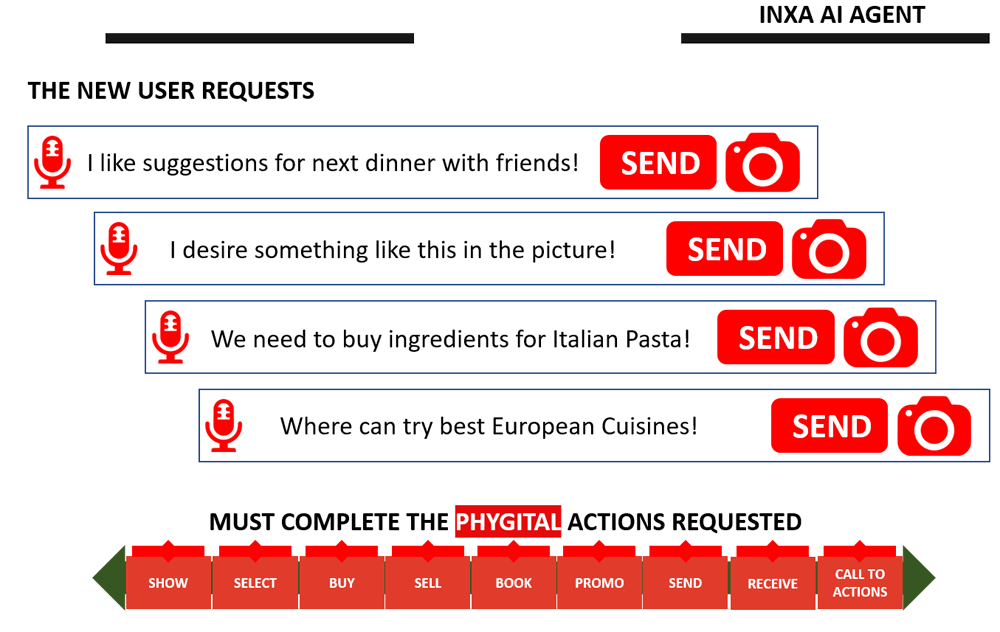
Understanding Phygital Actions
Phygital actions encompass a variety of tasks that bridge the gap between the digital and physical worlds. These include:
- Click-and-Collect Services: Allowing users to order online and pick up in-store.
- In-Store Digital Kiosks: Providing digital assistance within physical store locations.
- Augmented Reality (AR) Experiences: Enabling users to visualize products in their real-world environment via their smartphones or AR devices.
- Integrated Customer Support: Combining online chat support with in-store assistance for a consistent customer service experience.
Meeting User Expectations
Today's users demand seamless and efficient phygital interactions. For businesses, this means creating an infrastructure that can handle these requests smoothly and effectively. Here are key strategies to ensure new user requests meet and complete the phygital actions expected:
- Unified Systems: Integrate online and offline systems to ensure real-time synchronization of inventory, customer data, and order processing. This minimizes discrepancies and enhances the user experience.
- User-Friendly Interfaces: Design intuitive and easy-to-navigate interfaces for both digital and physical touchpoints. This ensures users can complete phygital tasks with minimal friction.
- Personalized Experiences: Leverage data analytics and AI to personalize phygital interactions. Tailored recommendations, personalized support, and context-aware services can significantly enhance user satisfaction.
- Robust Support Systems: Establish comprehensive support channels that can assist users in both digital and physical environments. This includes training staff to handle phygital queries and providing robust online help resources.
- Continuous Improvement: Regularly gather user feedback and analyze phygital action data to identify areas for improvement. This ongoing refinement ensures that user requests are consistently met with high-quality phygital solutions.
The Impact of Effective Phygital Actions
Successfully completing phygital actions as requested by new users can lead to numerous benefits for businesses:
- Increased Customer Satisfaction: Seamless phygital experiences enhance overall satisfaction, fostering loyalty and repeat business.
- Higher Conversion Rates: Smooth transitions between online and offline channels can reduce drop-offs and increase conversion rates.
- Enhanced Brand Perception: Effective phygital strategies can position a brand as innovative and customer-centric, improving market reputation.
- Operational Efficiency: Integrated systems and streamlined processes reduce operational complexities, leading to cost savings and better resource allocation.
In a world where digital and physical experiences are increasingly interconnected, it is crucial for businesses to ensure that new user requests are equipped to handle and complete phygital actions. By focusing on unified systems, user-friendly interfaces, personalized experiences, robust support, and continuous improvement, companies can meet these demands effectively. This not only enhances customer satisfaction and loyalty but also drives business success in the evolving retail landscape.
Beyond Generative AI
Beyond Generative Limits
Generative AI has gained widespread attention for its ability to generate text, images, and other media in response to prompts. These systems, like GPT-3, have demonstrated impressive capabilities in creating human-like content, making them valuable tools in various fields. However, despite their advancements, generative AI systems have significant limitations that hinder their adaptability, customization, and overall effectiveness in more complex and dynamic environments.
Limited Adaptability and Customization
Generative AI systems rely heavily on historical data-driven algorithms. This dependence on past data means that these systems can struggle to adapt to new, unforeseen scenarios or to customize outputs beyond their training. Their responses are constrained by the data they were trained on, which can lead to limitations in generating truly novel or context-specific content.
Lack of Real-Time Data Integration
One of the major shortcomings of generative AI is its inability to access and integrate third-party real-time data. This means that while they can produce content based on the data they have been trained on, they cannot update their knowledge or respond dynamically to new information as it becomes available. This static nature restricts their usefulness in applications requiring real-time decision-making and adaptability.
Inability to Perform Real Actions Generative AI systems can generate content, but they fall short when it comes to performing real actions, drawing conclusions, generating new ideas, or making decisions in complex situations. Their capabilities are limited to producing outputs based on patterns in their training data, without the capacity for deeper understanding, innovation, or strategic decision-making. This limitation is critical in environments where situational awareness and complex problem-solving are essential.
Static Knowledge Acquisition
Generative AI systems acquire the majority of their knowledge during training sessions. Once trained, they do not continue to learn or update their knowledge base. Moreover, they cannot share their knowledge with third-party systems, making it challenging to integrate them into broader AI ecosystems where continuous learning and information sharing are crucial.
High Implementation Costs
Implementing and maintaining generative AI platforms can be prohibitively expensive. The costs associated with developing, training, and deploying these systems, along with the computational resources required to run them, can be substantial. This financial barrier can limit the accessibility of generative AI technologies to only those organizations with significant resources, thus widening the gap between tech-savvy enterprises and smaller entities.
Looking Beyond Generative AI
To overcome the limitations of generative AI, there is a need to explore more advanced and integrated AI systems that can address these shortcomings. Potential directions for innovation include:
- Adaptive AI Systems: Developing AI that can learn and adapt in real-time, integrating new data and experiences to improve its performance continuously.
- Action-Oriented AI: Creating AI systems capable of performing real actions, making decisions, and generating new ideas based on complex, evolving situations.
- Interoperable AI Ecosystems: Building AI systems that can share knowledge and integrate seamlessly with third-party platforms, enabling a more collaborative and dynamic AI environment.
- Cost-Effective AI Solutions: Innovating to reduce the costs associated with AI implementation and maintenance, making advanced AI technologies more accessible to a broader range of organizations.
While generative AI has made significant strides in the realm of content creation, its limitations in adaptability, real-time data integration, action capability, continuous learning, and cost-effectiveness highlight the need for more advanced AI solutions. By moving beyond the current generative AI paradigm, we can develop more versatile, dynamic, and accessible AI systems that better meet the demands of complex and ever-changing environments.
INXA AI Agents: A Collective Network of Interconnected AI Nodes
INXA AI Agents introduce a groundbreaking approach to digital data representation, inspired by the intricacies of the human brain. This innovative system functions and interacts like a shared biological entity, aptly termed the "eBrain." By rethinking digital data through this lens, INXA AI Agents promise a transformative shift in how we manage and utilize information in the digital world.

The Concept of eBrain
The eBrain is a sophisticated digital construct that mimics the functionality of the human brain. It represents a collective network of interconnected AI nodes, each node acting as a part of a larger, cohesive system. This biological-like entity facilitates complex interactions and decision-making processes by leveraging the strengths of individual nodes while maintaining a unified operational framework.
QIAO TAGs: The Neurons of the Digital Biological World
Central to the functionality of the eBrain are QIAO TAGs. These tags act as the neurons of this new digital biological world, capable of managing deconstructed and geolocated information. Just as neurons in the human brain process and transmit information through synapses, QIAO TAGs interact to handle data in a decentralized and highly efficient manner. This decentralized approach allows for more dynamic and flexible data management, tailored to the specific needs and contexts of each interaction.
eDNAs: Microprograms for Complex Actions
eDNAs are microprograms designed to facilitate joint complex actions between different QIAO TAGs. These microprograms enable coordinated efforts among multiple tags, allowing for sophisticated data processing and action generation. The interaction between eDNAs and QIAO TAGs can produce outcomes that are greater than the sum of their parts, similar to how different parts of the brain collaborate to perform complex tasks.
Dynamic Interactions and Information Generation
In the INXA AI framework, information or actions are generated through the interaction between two or more QIAO TAGs. This interaction-based model allows for a highly adaptable and responsive system, capable of evolving and improving based on real-time data and interactions. The dynamic nature of these interactions ensures that the system can handle a wide range of tasks and challenges, making it incredibly versatile.
Replication and Scalability: Multiple eBrains
One of the most powerful aspects of the eBrain is its ability to be replicated across multiple AI nodes. Each eBrain can operate independently or as part of a larger network, offering unparalleled scalability. This means that the INXA AI system can be deployed in various environments and contexts, from small-scale applications to large, distributed networks, without losing its efficiency or effectiveness.
INXA AI API: Real-Time Connectivity
The INXA AI API serves as the sensory interface that connects the eBrain to third-party systems and external eBrains in real time. These APIs act as sensors, facilitating seamless integration and communication with other digital systems. This connectivity ensures that the eBrain remains up-to-date with the latest information and can interact with external data sources, enhancing its capabilities and broadening its applicability.
INXA AI Agents represent a revolutionary leap in artificial intelligence, redefining digital data representation and management through a biologically inspired framework. With QIAO TAGs functioning as digital neurons, eDNAs enabling complex interactions, and the capacity for dynamic replication and real-time connectivity, INXA AI Agents offer a powerful, adaptable, and scalable solution for the future of AI. This collective network of interconnected AI nodes, or eBrains, promises to transform how we interact with and utilize digital information, paving the way for more intelligent and responsive AI systems.
INXA AI Agents API: AI + Microprograms + Big Data for Phygital Experiences
The INXA AI Agents API combines advanced AI, Microprograms and Big Data to streamline the management of phygital experiences, ecommerce, inShop activities, and more—all in One-Click! This powerful integration offers a seamless and efficient solution for businesses looking to optimize their operations across both physical and digital world.
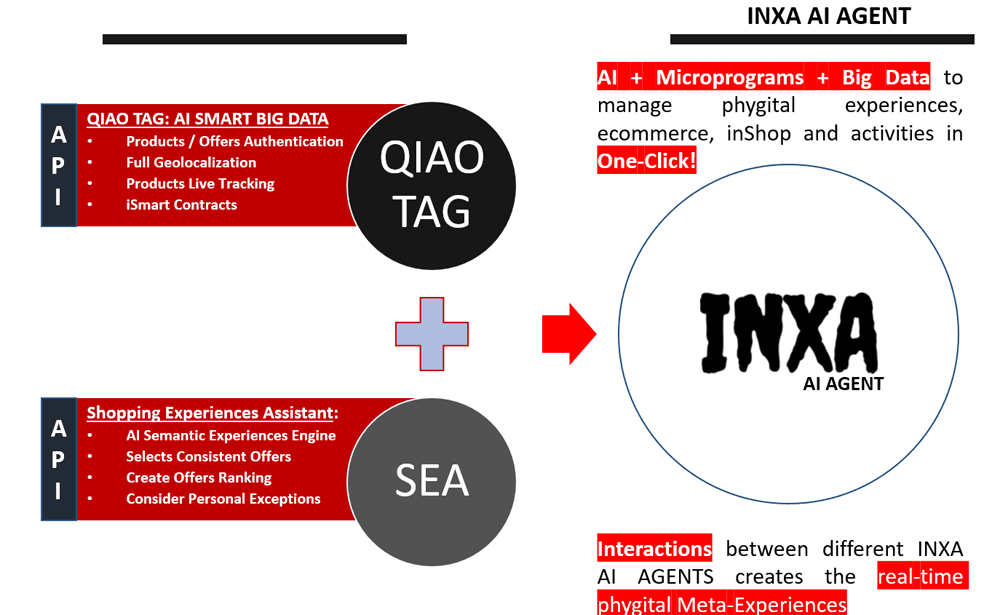
AI-Powered Management
At the core of INXA AI Agents API is sophisticated artificial intelligence that drives the system’s functionality. This AI component ensures intelligent decision-making, predictive analytics, and real-time responsiveness, enabling businesses to manage complex tasks effortlessly.
Microprograms for Tailored Interactions
Microprograms in the INXA framework act as specialized instructions that execute specific tasks with precision. These microprograms facilitate detailed and tailored actions, ensuring that each task is performed optimally and efficiently. Whether it’s customizing an ecommerce experience or handling inShop activities, microprograms provide the necessary granularity for effective management.
Big Data Integration
The integration of Big Data allows INXA AI Agents API to leverage vast amounts of information for better insights and decision-making. By analyzing trends, customer behavior, and market dynamics, the system can provide businesses with actionable intelligence that enhances their strategic planning and operational execution.
Phygital Experiences
Managing phygital experiences—where physical and digital interactions converge—requires a unique approach. INXA AI Agents API excels in this area by ensuring that all aspects of the customer journey are seamlessly integrated. This includes synchronizing online and offline activities, creating cohesive brand experiences, and maintaining consistency across all touchpoints.
Ecommerce Optimization
For ecommerce, the API provides tools that streamline operations, from inventory management to customer interactions. The AI-driven insights help optimize product listings, enhance customer service, and improve overall sales performance. The system’s ability to adapt and learn from data ensures that ecommerce businesses can stay ahead of the competition.
InShop Activity Management
InShop activities, such as promotions, customer service, and inventory control, are made more efficient with INXA AI Agents API. The system’s real-time capabilities ensure that in-store operations run smoothly, providing customers with a superior shopping experience.
One-Click Solutions
One of the standout features of INXA AI Agents API is its One-Click functionality. This feature simplifies complex processes, allowing businesses to execute tasks with a single click. From updating inventory to launching marketing campaigns, the One-Click solution reduces the time and effort required to manage various activities, enhancing overall efficiency.
INXA AI Agents API offers a comprehensive solution that combines AI, microprograms, and Big Data to manage phygital experiences, ecommerce, inShop activities, and more. With its intelligent, real-time capabilities and One-Click solutions, this API is designed to meet the needs of modern businesses, providing them with the tools to succeed in an increasingly interconnected and digital world.
Generative Ai Vs. INXA Ai Agents
Generative AI refers to artificial intelligence systems that can generate new data, such as text, images, audio, or video, based on the training data they have been exposed to. These systems use techniques like deep learning, neural networks, and generative adversarial networks (GANs) to learn patterns and distributions from the training data and then generate new, synthetic data that resembles the original data.
Examples of generative AI include:
- Text generation models like GPT-3, which can generate human-like text based on prompts or input.
- Image generation models like DALL-E and Stable Diffusion, which can create new images from textual descriptions.
- Music generation models that can compose new songs or melodies.
While generative AI excels in creating new content based on learned data, it has limitations in adaptability, customization, and real-time interaction. These systems rely heavily on historical data and are often unable to incorporate real-time data from external sources. They also face challenges in executing real actions, drawing conclusions, or making decisions based on complex, dynamic situations. Additionally, the implementation and maintenance of generative AI platforms can be costly.
INXA AI Agents, on the other hand, represent a collective network of interconnected AI nodes that rethink the representation of digital data. Inspired by the functioning of the human brain, INXA AI Agents behave in their interactions as a shared biological entity, known as the eBrain.
Key Features of INXA AI Agents:
- QIAO TAGs:
- Act as the neurons of this new digital biological world.
- Capable of managing completely deconstructed and geolocated information.
- eDNAs:
- Microprograms that facilitate joint complex actions between different QIAO TAGs.
- Enable seamless interactions and operations across the network.
- Interaction-Driven Information:
- Information or actions are generated by the interaction between two or more QIAO TAGs.
- This dynamic interaction leads to more adaptable and customized responses.
- Replicable eBrains:
- The eBrain can be replicated across many AI nodes, creating a robust and distributed network.
- Real-Time Connectivity:
- INXA AI API functions as sensors to connect in real time to third-party and external eBrains.
- This connectivity allows for continuous learning, direct access to external data, adaptability, and real-time decision-making.
Advantages of INXA AI Agents over Generative AI:
INXA AI Agents bring a host of advantages over traditional generative AI systems, particularly through their enhanced capabilities in perception, interaction, and decision-making. Here’s an in-depth look at why INXA AI Agents are a step ahead:
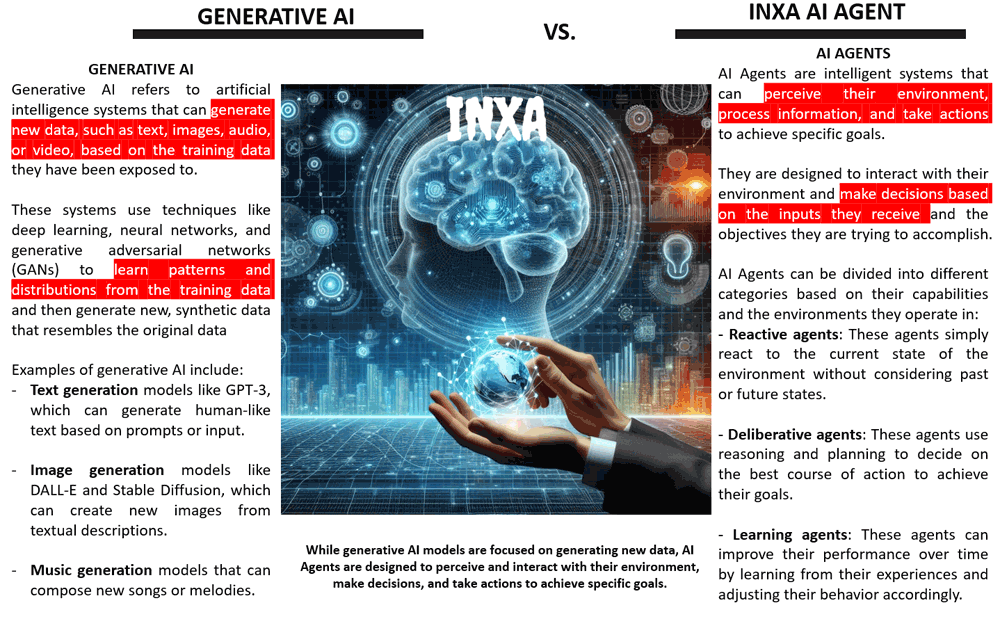
Intelligent Systems with Perception and Action
AI Agents are intelligent systems capable of perceiving their environment, processing information, and taking actions to achieve specific goals. Unlike generative AI, which primarily focuses on creating new content based on learned patterns, AI agents are designed to interact with their environment dynamically. This capability allows them to:
- Adapt to Real-Time Changes: AI Agents can continuously assess and respond to changes in their environment, making real-time adjustments to their actions and strategies. This adaptability is crucial for environments that are constantly evolving.
- Make Informed Decisions: By processing a wide array of inputs from their surroundings, AI Agents can make decisions that are informed by the current context and specific objectives.
Categories of AI Agents
AI Agents can be divided into different categories based on their capabilities and the environments they operate in:
- Reactive Agents:
- These agents respond directly to the current state of the environment without considering past or future states.
- They are useful in situations where quick, responsive actions are required.
- Deliberative Agents:
- These agents use reasoning and planning to decide on the best course of action to achieve their goals.
- They can weigh different options and anticipate the outcomes of their actions, making them suitable for complex decision-making scenarios.
- Learning Agents:
- These agents improve their performance over time by learning from their experiences and adjusting their behavior accordingly.
- This continuous learning process allows them to refine their strategies and actions based on past successes and failures.
Advantages of INXA AI Agents
- Real-Time Adaptability:
- Generative AI relies heavily on historical data and predefined algorithms, which limits its adaptability to new situations.
- INXA AI Agents continuously learn from real-time data and interactions, allowing them to adapt to new conditions and unforeseen challenges effectively.
- Interconnected Operations:
- Generative AI operates in isolation, creating content based on learned patterns.
- INXA AI Agents function as part of a collective network (e.g., eBrain) of interconnected AI nodes. This interconnectedness allows them to share information, coordinate actions, and achieve complex goals that are beyond the reach of standalone systems.
- Enhanced Customization:
- Generative AI can generate a wide variety of content but lacks the ability to tailor its actions to specific, individualized contexts.
- INXA AI Agents can manage geolocated information and execute microprograms (eDNAs) that enable highly customized and precise actions based on specific environmental factors and user requirements.
- Continuous Learning and Improvement:
- Generative AI systems acquire most of their knowledge during training sessions and cannot continue learning post-deployment.
- INXA AI Agents are learning agents that improve their performance over time by learning from their interactions and experiences, making them more efficient and effective in the long run.
- Cost Efficiency:
- Generative AI platforms often require significant resources for implementation and maintenance.
- INXA AI Agents, with their distributed nature and real-time adaptability, can potentially reduce costs by leveraging interconnected networks and real-time data, optimizing resource usage and operational efficiency.
INXA AI Agents represent a significant evolution in AI technology, offering superior adaptability, interconnectedness, and real-time decision-making capabilities. These features make them better suited for managing complex, dynamic environments and achieving specific goals with higher efficiency and customization compared to traditional generative AI systems.
Concrete Applications of Generative AI
Generative AI encompasses a wide range of applications across different domains, harnessing advanced algorithms to create new data in various formats. Here are some key types of generative actions and their concrete applications:
3D Generation
Applications:
- Gaming and Virtual Reality: Generative AI can create realistic 3D models of characters, environments, and objects, enhancing the immersive experience in video games and virtual reality applications.
- Architecture and Interior Design: AI can generate detailed 3D models of buildings and interior spaces, helping architects and designers visualize projects more effectively.
Example Tools:
- NVIDIA Omniverse: A platform for real-time collaboration and simulation in 3D design and virtual worlds.
Video Generation
Applications:
- Content Creation: AI can generate video content for marketing, entertainment, and educational purposes, reducing the time and cost associated with traditional video production.
- Deepfake Technology: Creating realistic videos of individuals by swapping faces or altering facial expressions, often used in film production and social media.
Example Tools:
- Synthesia: A platform for creating AI-generated videos with human avatars, commonly used for training and corporate communication.
Audio/Music Generation
Applications:
- Music Composition
- Voice Synthesis: Generating human-like voices for virtual assistants, audiobooks, and customer service applications.: AI can compose original music pieces in various genres, aiding musicians and composers in the creative process.
Example Tools:
- Amper Music: An AI music composition tool that allows users to create music tracks by specifying style and mood.
- Lyrebird AI: A voice synthesis tool that can mimic a person’s voice based on a few minutes of audio.
Image Generation
Applications:
- Art and Design: AI can create original artworks or assist designers by generating unique visual elements.
- Product Design: Generating new product concepts and variations, accelerating the design process.
Example Tools:
- DALL-E: An AI model by OpenAI that generates images from textual descriptions, capable of creating highly detailed and imaginative visuals.
- DeepArt: A platform that uses AI to transform photos into artworks inspired by famous styles.
Text Generation Models
Applications:
- Content Writing: AI can write articles, blog posts, and reports, helping content creators produce high-quality written material quickly.
- Chatbots and Virtual Assistants: Generating natural language responses in customer service and personal assistant applications.
Example Tools:
- GPT-3: A powerful language model by OpenAI that can generate human-like text based on prompts, used for a variety of text generation tasks.
Code Generation
Applications:
- Software Development: AI can generate code snippets, automate repetitive coding tasks, and even assist in debugging and testing.
- Low-Code/No-Code Platforms: Helping non-developers create software applications by generating code based on high-level specifications.
Example Tools:
- GitHub Copilot: An AI-powered code completion tool that suggests code snippets and entire functions in real-time as developers write code.
Molecular/Protein Structure Generation
Applications:
- Drug Discovery: AI can generate new molecular structures with potential therapeutic effects, accelerating the drug discovery process.
- Protein Engineering: Designing novel proteins with specific functions for use in biotechnology and medicine.
Example Tools:
- AlphaFold: An AI system by DeepMind that predicts protein structures with high accuracy, aiding in biological research and drug development.
Healthcare Applications
Applications:
- Medical Imaging: AI can generate enhanced medical images, improving the accuracy of diagnoses and treatment plans.
- Personalized Medicine: Creating patient-specific treatment plans based on generative models that analyze genetic and clinical data.
Example Tools:
- Zebra Medical Vision: An AI platform that generates insights from medical imaging data to assist radiologists and clinicians.
More Innovative Applications with generative Ai
- Fashion Design: Generative Fashion Models: AI can design new clothing items and accessories by generating patterns and styles that align with current trends.
- Synthetic Data Generation: Data Augmentation: Generating synthetic data to augment training datasets, improving the performance of machine learning models in areas with limited real-world data.
- Legal Document Drafting: AI can generate legal documents such as contracts and agreements, streamlining the legal drafting process and ensuring compliance with legal standards.
Generative AI is transforming numerous industries by providing innovative solutions that enhance creativity, efficiency, and productivity. From art and entertainment to healthcare and software development, the potential applications of generative AI continue to expand, driven by ongoing advancements in machine learning and artificial intelligence technologies.
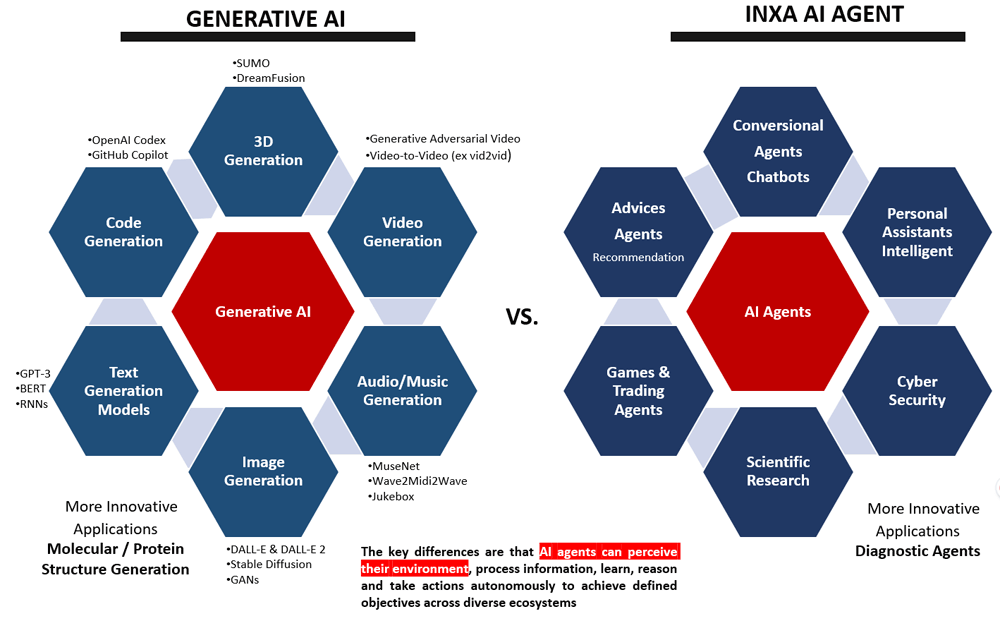
Concrete Applications of AI Agents
AI agents are intelligent systems capable of perceiving their environment, processing information, and taking actions to achieve specific goals. Here are some key types of AI agents and their concrete applications:
Conversational Agents (Chatbots)
Applications:
- Customer Service: Chatbots provide instant responses to customer inquiries, handling common issues and improving customer satisfaction.
- E-commerce: Assisting customers with product recommendations, order tracking, and shopping assistance.
Example Tools:
- Intercom: A platform that provides AI-driven chatbots for customer engagement and support.
- Drift: A conversational marketing platform that uses chatbots to qualify leads and schedule meetings.
Personal Assistants
Applications:
- Scheduling and Reminders: AI personal assistants manage calendars, set reminders, and schedule meetings.
- Smart Home Control: Controlling smart home devices through voice commands, such as adjusting thermostats or turning lights on and off.
Example Tools:
- Google Assistant: An AI-powered virtual assistant that performs a variety of tasks through voice commands.
- Amazon Alexa: A virtual assistant that interacts with users, answers questions, and controls smart home devices.
Intelligent Cyber Security Agents
Applications:
- Threat Detection: Identifying and mitigating cyber threats in real-time by analyzing network traffic and user behavior.
- Incident Response: Automating responses to security incidents, reducing the time to containment and recovery.
Example Tools:
- Darktrace: A cybersecurity platform that uses AI to detect and respond to cyber threats.
- CrowdStrike Falcon: An AI-powered platform for endpoint protection and threat intelligence.
Scientific Research Agents
Applications:
- Data Analysis: AI agents assist researchers in analyzing large datasets, identifying patterns, and generating insights.
- Literature Review: Automatically summarizing and extracting key information from scientific papers.
Example Tools:
- IBM Watson: A platform that provides AI-driven data analysis and natural language processing for scientific research.
- Semantic Scholar: An AI-powered research tool that helps scientists discover and understand scientific literature.
Gaming and Trading Agents
Applications:
- Game AI: Enhancing non-player characters (NPCs) and creating adaptive gameplay experiences.
- Automated Trading: AI agents execute trades in financial markets based on pre-defined strategies and real-time data analysis.
Example Tools:
- Unity ML-Agents: A toolkit for training intelligent agents in Unity-powered games.
- AlgoTrader: An algorithmic trading software that uses AI to develop and deploy trading strategies.
Advice and Recommendation Agents
Applications:
- Content Recommendation: AI agents suggest articles, videos, and other content based on user preferences and behavior.
- Product Recommendations: Providing personalized product suggestions in e-commerce platforms to enhance the shopping experience.
Example Tools:
- Netflix Recommendation System: An AI-driven system that suggests movies and TV shows to users based on their viewing history.
- Amazon Personalize: A machine learning service that provides personalized recommendations for products, content, and promotions.
Diagnostic Agents
Applications:
- Healthcare Diagnostics: AI agents analyze medical data, such as imaging and lab results, to assist in diagnosing diseases.
- Predictive Maintenance: Monitoring equipment and predicting failures to prevent downtime in industrial settings.
Example Tools:
- IBM Watson Health: An AI platform that supports healthcare professionals in diagnosing and treating patients.
- Uptake: An industrial AI platform that uses predictive analytics for equipment maintenance.
More Examples
- Educational Agents: Tutoring and Personalized Learning: AI agents provide personalized tutoring and learning recommendations based on student performance and learning styles.
- Example Tools: Khan Academy - Uses AI to personalize learning paths for students, providing tailored content and practice exercises.
- Legal Document Drafting Agents: Contract Generation: AI agents assist in drafting legal documents, ensuring compliance with legal standards and reducing manual effort.
- Example Tools: LawGeex - An AI-powered platform for automating contract review and approval processes.
- HR and Recruitment Agents:
- Resume Screening: AI agents analyze resumes and shortlist candidates based on job requirements.
- Employee Onboarding: Automating the onboarding process for new hires, including document collection and training schedules.
- Example Tools: HireVue - Uses AI to assess candidate interviews and evaluate their suitability for job roles
AI agents are transforming various industries by providing intelligent solutions that enhance efficiency, accuracy, and user experience. From customer service and healthcare to cybersecurity and scientific research, the applications of AI agents continue to grow, driven by advancements in artificial intelligence and machine learning technologies.
INXA Ai Agent Applications
Ai XMaps: Your World Around You
XMaps is an innovative application powered by INXA AI Agents, designed to simplify your interactions with the digital and physical world.
No more browsing through countless websites, apps, eShops, or offline stores.
With AI XMaps, a personalized meta-world is created around you, offering seamless and efficient access to what you need, when you need it in one click.
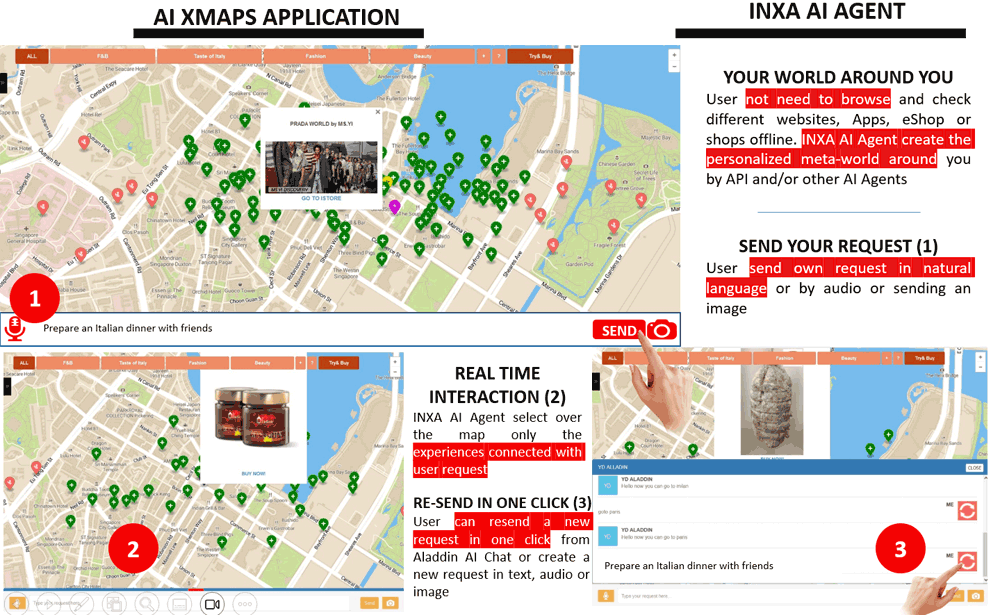
Key Features
Personalized Meta-World Creation
- INXA AI Agents: By leveraging INXA AI Agents, the application tailors the digital world to your preferences and needs. AI Agents interact with various APIs and other AI systems to curate the most relevant experiences for you.
- User-Centric Mapping: The AI selects and highlights only those experiences and services on the map that align with your specific requests, ensuring you get a customized and relevant user experience and an interaction Ai Text-to-Business more effective by text, voice and image.
Real-Time Interaction
- Instant Updates: Experiences and services are updated in real-time, reflecting the latest information and availability based on your requests.
- Dynamic Adjustments: The AI Agent continuously refines and adjusts the selections to match your evolving preferences and immediate needs.
- INXA Ai Text-to-Business : a cutting-edge technology that transforms natural language inputs written or vocal commands into automated actions, complex business operations, automating tasks across various enterprise functions, streamlining workflows and enhancing user interactions across various digital platforms by Api.
One-Click Re-Request
- Effortless Resend: With the Aladdin AI Chat interface, users can resend a new request with just one click, streamlining the process of finding what they need.
- Flexible Request Formats: Users can create new requests in multiple formats, including text, audio, or image, ensuring convenience and accessibility.
How It Works
- User Request Submission: Submit your request through the Aladdin AI Chat or by using text, audio, or image inputs.
- AI Agent Processing: INXA AI Agents analyze your request and interact with various APIs and AI systems to gather relevant data and experiences.
- Personalized Meta-World Display: INXA AI Agents populate the map with personalized and geolocated experiences that match your request, creating a customized meta-world
- Real-Time Updates: The selected experiences and services on the map are updated in real-time to reflect the latest information.
- One-Click Re-Request:Easily resend your request with one click via Aladdin AI Chat or submit a new request in your preferred format.
Benefits
- Convenience: No need to browse multiple platforms; everything you need is curated in one place
- Personalization: Tailored experiences based on your specific preferences and needs
- Efficiency: Quick and easy access to relevant services and experiences
- Real-Time Interaction: Up-to-date information and dynamic adjustments to ensure the best possible user experience
Experience the Future with AI XMaps: YOUR WORLD AROUND YOU With AI XMaps, the world around you is personalized and optimized to meet your needs. Enjoy the convenience of having the digital and physical world tailored to your preferences, making your life easier and more efficient.
INXA Ai iTV Application
Experience the Future of Television with Dynamic iTV
The INXA AI iTV application revolutionizes the television experience by leveraging advanced AI technologies to create a highly personalized and interactive viewing environment. This dynamic iTV experience is context-based, ensuring that every aspect of your viewing journey is tailored to your preferences and real-time interactions.
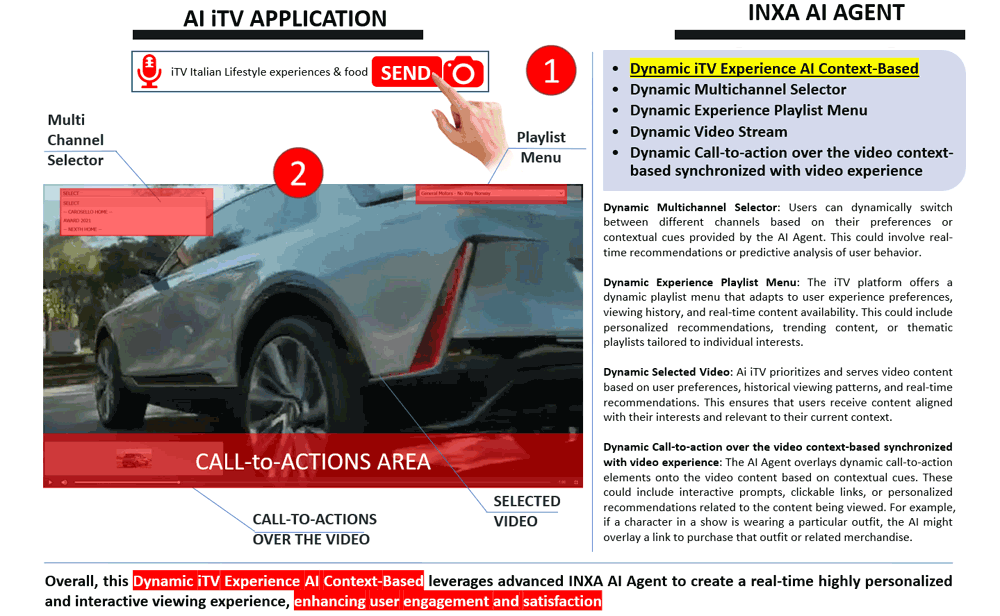
Key Features
Dynamic Multichannel Selector
- Personalized Channel Switching: Users can seamlessly switch between different channels based on their preferences or contextual cues provided by the AI Agent.
- Real-Time Recommendations: The AI Agent offers real-time channel recommendations and predictive analysis of user behavior to ensure the best viewing options are always available.
Dynamic Experience Playlist Menu
- Adaptive Playlists: The iTV platform presents a dynamic playlist menu that evolves according to user experience preferences, viewing history, and real-time content availability.
- Personalized Recommendations: Enjoy playlists featuring trending content, thematic collections, and personalized suggestions tailored to your interests
Dynamic Video Stream
- Prioritized Content Delivery: AI iTV prioritizes and delivers video content based on user preferences, historical viewing patterns, and real-time recommendations.
- Context-Relevant Viewing: Ensures that users receive video content aligned with their interests and relevant to their current context, enhancing overall satisfaction.
Dynamic Call-to-Action Overlays
- Context-Based Interactions: The AI Agent overlays dynamic call-to-action elements onto the video content based on contextual cues
- Interactive Prompts: Engage with interactive prompts, clickable links, and personalized recommendations related to the content being viewed
- Integrated Commerce: For example, if a character in a show is wearing a particular outfit, the AI might overlay a link to purchase that outfit or related merchandise, creating a seamless shopping experience
How It Works
- User Preferences and Context Analysis: The AI Agent analyzes user preferences, viewing history, and real-time context to deliver personalized content and recommendations
- Dynamic Content Delivery: Content is dynamically selected and prioritized to match user interests, ensuring a continuously engaging viewing experience
- Real-Time Interactivity: Interactive elements and call-to-action overlays are synchronized with the video content, providing contextual engagement opportunities
- Adaptive Playlist and Channel Management: The playlist menu and channel selector adapt in real-time to user preferences and context, offering an intuitive and personalized navigation experience
Benefit
- Enhanced User Engagement: Personalized and context-aware content keeps users engaged and satisfied
- Seamless Interactivity: Interactive prompts and overlays create an immersive viewing experience
- Efficient Content Discovery: Real-time recommendations and adaptive playlists simplify content discovery and enhance user experience
- Integrated Shopping: Contextual call-to-action overlays facilitate seamless commerce opportunities
Experience the Future with INXA AI iTV With INXA AI iTV, television viewing is transformed into a dynamic, personalized, and interactive experience. Leveraging the power of advanced AI Agents, the platform ensures that every aspect of your viewing journey is tailored to your preferences and real-time interactions. Enjoy a future where television is more than just passive entertainment—it's an engaging, personalized, and immersive experience.
INXA Ai XHubs Application
Nexth Ai Hubs integrates AI innovation with international cross-border business and trading within its interactions. Using a new interface that activates the capabilities of SEEN & TOUCH and SEEN & ACT, INXA Ai XHubs revolutionizes the way businesses operate and interact globally.
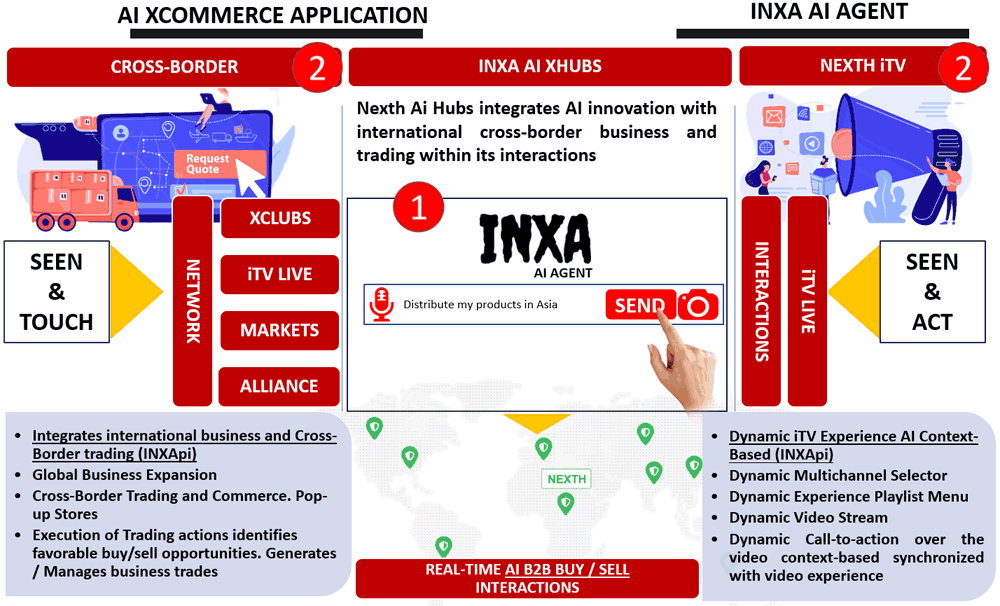
Benefits
- Enhanced Global Reach: Expand business operations seamlessly across international borders.
- Optimized Trading Opportunities: Real-time identification and management of favorable trading opportunities.
- Personalized User Experience: Tailored content and interactions for users, increasing engagement and satisfaction.
- Efficient Business Management: Streamlined processes for setting up and managing international commerce activities.
- Interactive Viewing Experience: Dynamic, context-based content that enhances user engagement with iTV applications.
SEEN & TOUCH: Integrates International Business and Cross-Border Trading (INXApi)
- Global Business Expansion: Leverage AI-driven insights and analytics to identify and penetrate new markets. INXA Ai XHubs provides tools and resources to facilitate expansion and smooth business operations across international borders.
- Cross-Border Trading and Commerce: Use AI to manage logistics, compliance, and local regulations for setting up pop-up stores and other commerce activities. The system ensures seamless operations and optimizes the supply chain.
- Execution of Trading Actions: Utilize real-time data analytics to monitor market trends and identify profitable trading opportunities. The AI system generates actionable insights and automates trade execution, ensuring timely and efficient transactions. Identify favorable buy/sell opportunities in real-time, generate, and manage business trades effectively.
SEEN & ACT: Dynamic iTV Experience AI Context-Based (INXApi)
- Dynamic Multichannel Selector: Allow users to switch between different channels dynamically, based on their preferences or contextual cues provided by the AI agent. This feature uses real-time recommendations and predictive analysis of user behavior.
- Dynamic Experience Playlist Menu: The iTV platform offers a dynamic playlist menu that adapts to user experience preferences, viewing history, and real-time content availability. This includes personalized recommendations, trending content, and thematic playlists tailored to individual interests.
- Dynamic Video Stream: Prioritize and serve video content based on user preferences, historical viewing patterns, and real-time recommendations. This ensures that users receive content aligned with their interests and relevant to their current context.
- Dynamic Call-to-Action Over the Video Context-Based Synchronized with Video Experience: The AI overlays interactive call-to-action elements on the video content. These elements, such as clickable links or personalized prompts, are contextually synchronized with the video, providing users with relevant options and enhancing engagement. For instance, if a user watches a cooking show, the AI might display links to purchase ingredients or related recipes or if a character in a show is wearing a particular outfit, the AI might overlay a link to purchase that outfit or related merchandise.
Overall, INXA Ai XHubs provides a comprehensive solution for businesses looking to leverage AI for international expansion and dynamic, personalized user experiences. This application enhances user engagement, satisfaction, and business efficiency through advanced AI capabilities.
INXA Ai XCommerce Application
The INXA Ai XCommerce application offers an integrated solution for businesses to expand their operations globally, leveraging real-time AI insights and seamless cross-border trading capabilities.
By leveraging the INXA Ai XCommerce application, businesses can seamlessly expand their operations globally, optimize trading activities, and achieve their business objectives with the power of AI-driven insights and automation.
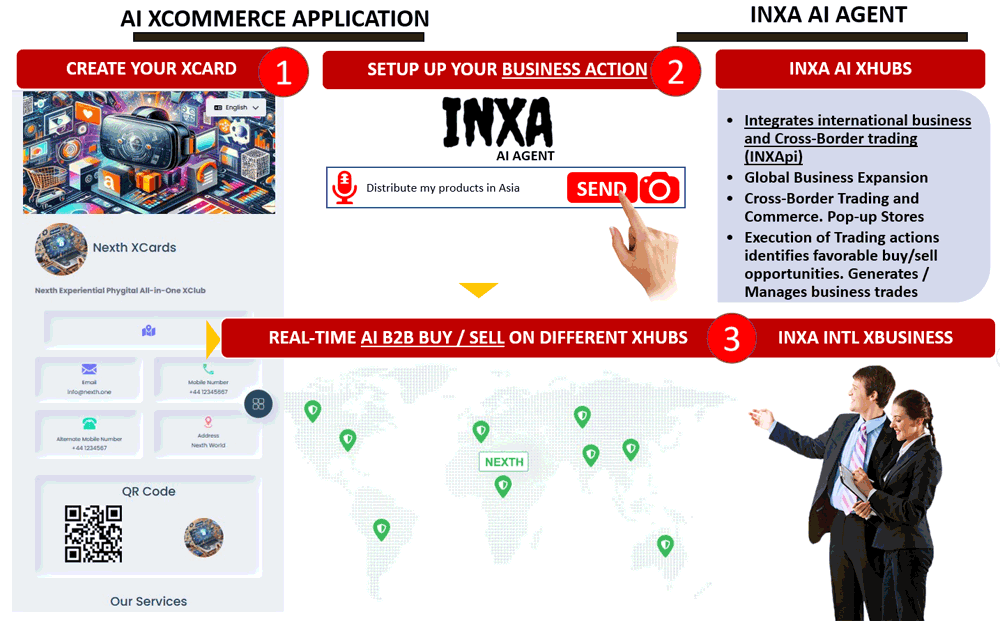
How It Works
- Create Your XCard with Nexth.Me: Build a comprehensive business VCard that includes company details, product listings, and trading preferences for sharing on Nexth Ecosystem.
- Set Up Your Business Action and Market Analysis: Define your business objectives and target markets. INXA Ai analyzes market trends, consumer behavior, and regulatory requirements to provide a tailored market entry strategy. Receive recommendations on how to adapt your products and marketing strategies to fit local markets.
- Market Entry Strategy: Use AI-driven market analysis to identify the best strategies for entering new markets (Example distributing your products in Asia).
- Localization: Adapt your business practices to local cultures, regulations, and consumer behaviors with the help of INXA Ai insights.
- Partnership Opportunities: Discover potential partners and distributors in your target markets through AI matchmaking.
- Activate INXA AI XHUBS: Using INXA Ai new Interface digit your request (e.g., Distribute My Products in Asia). This activate Real-Time Trading and Engage in real-time B2B trading activities, leveraging AI to identify and execute profitable buy/sell opportunities, real-time B2B trading on XHubs, using AI to monitor market conditions and identify profitable opportunities.

- Manage Cross-Border Trading:
- Logistics and Compliance: Use AI to streamline logistics, manage supply chains, and ensure compliance with local regulations.
- Automated Trading Actions: INXA Ai automates trading actions, such as buy/sell orders, to optimize your trading strategy and maximize profitability.
- Real-Time AI B2B Buy/Sell:
- AI-Driven Insights: Leverage AI analytics to gain insights into market trends and trading opportunities.
- Trade Execution: Automate trade executions based on real-time data, ensuring timely and profitable transactions.
Benefits
- Global Business Expansion: Effortlessly scale your business across international borders with AI-guided strategies and insights.
- Optimized Trading Opportunities: Maximize profitability by identifying and capitalizing on favorable trading conditions in real time.
- Streamlined Operations: Simplify and automate cross-border trading processes, from logistics to compliance.
- Enhanced Market Penetration: Use AI-driven market entry strategies to effectively penetrate new markets and grow your customer base.
- Efficient Business Management: Manage your international business operations efficiently with AI tools that provide actionable insights and automation.
Key Features
Real-Time Support
INXA AI Agents provide immediate assistance to users, helping them navigate the platform and find the information or services they need. This real-time support ensures that users have a smooth and efficient experience.
Personalized Recommendations
Using data analysis and machine learning algorithms, INXA AI Agents offer personalized recommendations tailored to each user's preferences and behaviors. This level of personalization enhances user satisfaction and engagement.
Intelligent Insights
INXA AI Agents generate valuable insights based on user interactions and data. These insights help businesses understand user behavior, optimize their offerings, and make informed decisions to improve the overall experience.
Benefits
Enhanced User Experience
The integration of INXA AI Agents into the Nexth.one platform significantly enhances the user experience by providing timely support and personalized interactions. This leads to higher user satisfaction and loyalty.
Increased Efficiency
By automating routine tasks and providing quick responses, INXA AI Agents increase the efficiency of the platform. Users can accomplish their goals faster, and businesses can streamline their operations.
Data-Driven Decisions
The insights generated by INXA AI Agents enable businesses to make data-driven decisions. This helps in identifying trends, optimizing services, and improving user engagement.
Applications
INXA AI Agents can be utilized in various applications across different industries, including:
- Retail: Assisting customers with product information, personalized shopping recommendations, and support.
- Entertainment: Enhancing user experiences with personalized content suggestions and interactive features.
- Education: Providing students with personalized learning resources and support.
- Healthcare: Offering patients virtual assistance, appointment scheduling, and personalized health recommendations.
All-in-One Phygital Ecosystem Management
INXA AI Agents are integrate to the management of Nexth.one’s All-in-One Phygital Ecosystem. This ecosystem combines physical and digital elements to create a cohesive and immersive experience, managed effectively through the intelligent capabilities of INXA AI Agents. Key aspects of ecosystem management include:
- Seamless Integration: Ensuring smooth interaction between various components of the ecosystem, both physical and digital.
- Dynamic Adaptation: Continuously adapting to user needs and preferences to maintain high levels of engagement and satisfaction.
- Operational Efficiency: Streamlining operations and processes within the ecosystem to deliver a seamless user experience.
- Comprehensive Analytics: Utilizing data from user interactions to generate insights and optimize ecosystem performance.
Conclusion
INXA AI Agents are a vital component of the Nexth Experiential Phygital All-in-One XClub platform, bringing advanced AI capabilities to enhance user interactions and provide valuable insights. By leveraging these intelligent agents, businesses can offer more personalized, efficient, and engaging experiences to their users. Additionally, INXA AI Agents play a crucial role in managing the All-in-One Phygital Ecosystem, ensuring seamless integration and operation of its diverse components.
For more information, visit Nexth.one.
